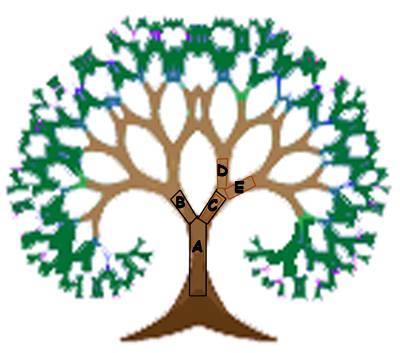Nature Repeats Herself – Fractal Trees and PBS Nova
PBS recently broadcast their Nova program about fractals, an amazing new branch of mathematics that helps us describe natural things like trees, mountains and clouds.
I’ve been fascinated with fractals since their discovery in the 1970′s and 1980′s. They totally changed my view of nature. Because when we look at natural objects, they look complex. But it turns out nature creates this complexity from simple things, just doing them over and over again.
The concept of fractals is called self-similarity — that is to say when you look at a fractal object and then parts of that object, and parts of those parts, they are the same shape, just repeated.
Pictured above is a fractal tree, simply drawn by one line becoming two (A becoming B and C), then each of those becoming two (like C becoming D and E), over and over again. The complex shape that results looks like a natural tree, or a natural broccoli shape.
The tree image above was completely generated by a computer program. It’s a simple example of the concept. Many fractal images, much more complex than this, will take your breath away.
Interesting in it’s own right — but fractals have practical purposes too. Some of the mountain scenes in Star Wars, which look very natural and realistic, were completely generated by fractal computer programs.
Fractals are also being used to estimate the total amount of carbon dioxide that some of the rain forest can absorb. Using the self-similarity concept, scientists can just measure a few sample trees and the carbon dioxide content of their leaves, and calculate the total CO2 uptake of the forest.
This of course, is important in our continuing studies of global warming. So fractals play an important role for us.
But my favorite aspect of them comes back to the simplicity of nature and how she uses this simplicity to create the beautiful, complex things in the world – like trees and forests.
That’s nature’s way — simple, complex, elegant and beautiful, all at the same time.
J. Daniel




